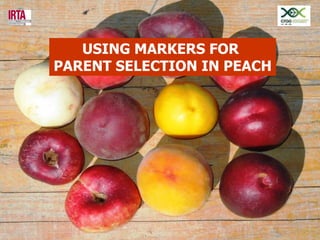03 arus
- 1. USING MARKERS FOR PARENT SELECTION IN PEACH
- 2. MARKERS FOR PEACH BREEDING 1. PARENT CHARACTERIZATION AND SELECTION âĒ Relationships between parents âĒ Cross planning o Genetic distances o Heterozygosity âĒ Breederâs rights enforcement 2. SEEDLING MARKER-ASSISTED SELECTION 3. MARKER-ASSISTED INTROGRESSION
- 3. 167 178 183 189 141 147 141 147 141 147 125 129 131 131 125 131125178 183 189 178 PEDIGREE VALIDATION P 1 P 2 H-A H-B
- 4. SELECTING PARENTS FOR A CROSS: GENETIC DISTANCE Do my pedigree data fit? The DENDROGRAM Clusters group genetically similar parents Do I need more variability? Do I want to have a fixed background where only a few traits segregate?
- 5. SELECTING PARENTS FOR A CROSS: HETEROZYGOSITY More heterozygosity in the parents ï More segregation in the progeny 0 20 30 40 50 6010 % Heterozygosity
- 6. MARKER (SSR) FINGERPRINTING FOR BREEDERâS RIGHTS PROTECTION
- 7. Procedure for Cultivar Identification for Breederâs Rights Protection Creation of a DataBase with the molecular profiles Base de Datos âĒ With the Spanish breederâs association (GESLIVE) âĒ Samples collected from official sources
- 8. Comparison between the fingerprints of a problem samples and the DB Database Fingerprint coincides with Var. 7 (Calculate the probability of inding by chance another variety with same fingerprint) Procedure for Cultivar Identification for Breederâs Rights Protection
- 9. M3 MARKER-ASSISTED SELECTION 0-5 cM M2 LINKED MARKERS: Require validation in a progeny (phase knowledge) DIAGNOSTIC MARKERS: Presence of certain alleles predict corresponding phenotypes M1IDEALLY âDIAGNOSTCâ MARKERS. FOR LINKED MARKERS WE HAVE TO KNOW THE PHASE MARKER-SELECTED GENE
- 10. Ã Ã Ã Ã Ã
- 11. A WHOLE-GENOME VIEW OF THE PARENTS OF A BREEDING PROGRAM (9K PEACH CHIP)
- 12. Thank you











